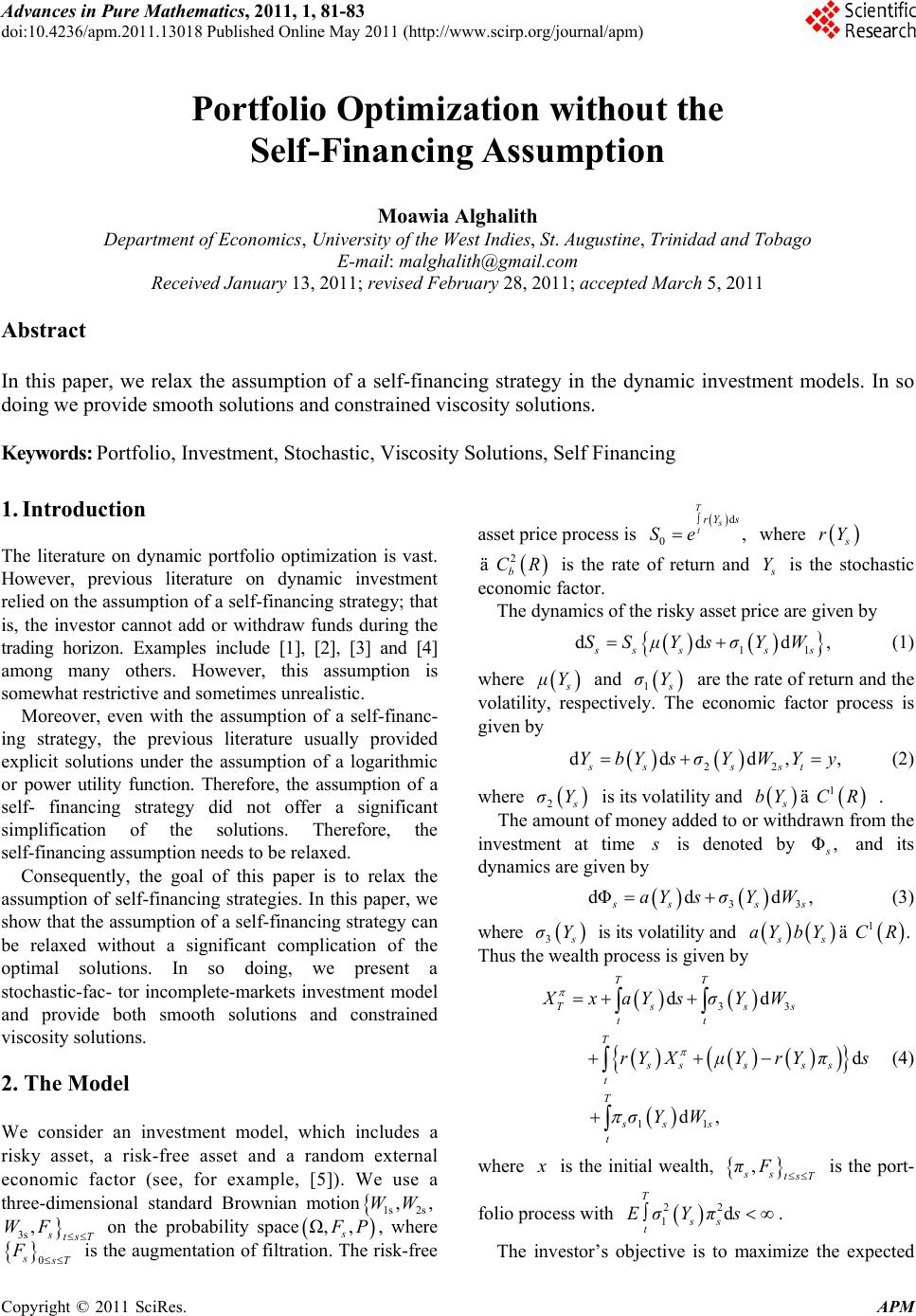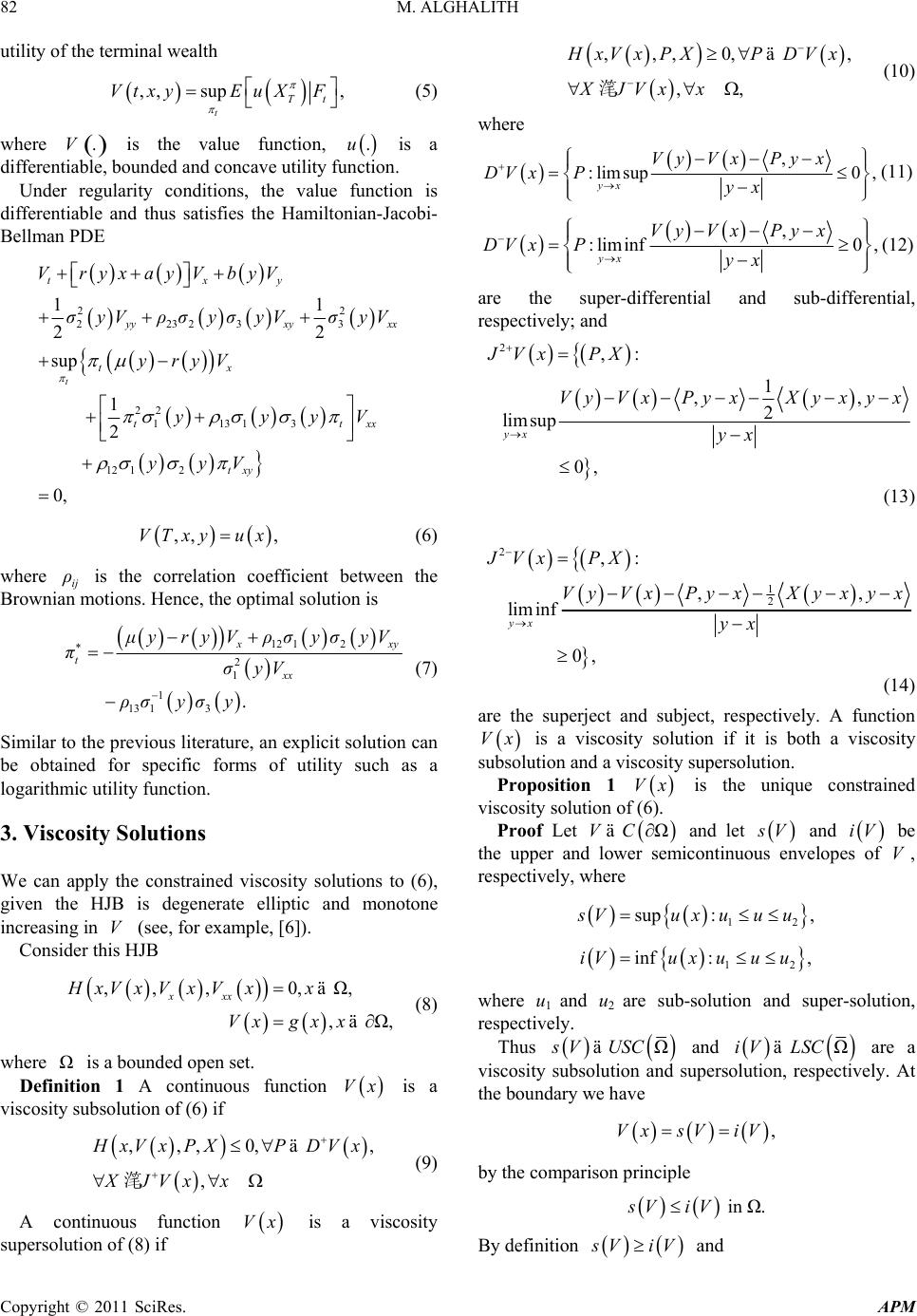Paper Menu >>
Journal Menu >>
 Advances in Pure Mathematics, 2011, 1, 81-83 doi:10.4236/apm.2011.13018 Published Online May 2011 (http://www.scirp.org/journal/apm) Copyright © 2011 SciRes. APM Portfolio Optimization without the Self-Financing Assumption Moawia Alghalith Department of Economics, University of the West Indies, St. Augustine, Trinidad and Tobago E-mail: malghalith@gmail.com Received January 13, 2011; revised February 28, 2011; accepted March 5, 2011 Abstract In this paper, we relax the assumption of a self-financing strategy in the dynamic investment models. In so doing we provide smooth solutions and constrained viscosity solutions. Keywords: Portfolio, Investment, Stochastic, Viscosity Solutions, Self Financing 1. Introduction The literature on dynamic portfolio optimization is vast. However, previous literature on dynamic investment relied on the assumption of a self-financing strategy; that is, the investor cannot add or withdraw funds during the trading horizon. Examples include [1], [2], [3] and [4] among many others. However, this assumption is somewhat restrictive and sometimes unrealistic. Moreover, even with the assumption of a self-financ- ing strategy, the previous literature usually provided explicit solutions under the assumption of a logarithmic or power utility function. Therefore, the assumption of a self- financing strategy did not offer a significant simplification of the solutions. Therefore, the self-financing assumption needs to be relaxed. Consequently, the goal of this paper is to relax the assumption of self-financing strategies. In this paper, we show that the assumption of a self-financing strategy can be relaxed without a significant complication of the optimal solutions. In so doing, we present a stochastic-fac- tor incomplete-markets investment model and provide both smooth solutions and constrained viscosity solutions. 2. The Model We consider an investment model, which includes a risky asset, a risk-free asset and a random external economic factor (see, for example, [5]). We use a three-dimensional standard Brownian motion 1s 2s ,,WW 3s ,stsT WF on the probability space Ω,, s F P, where 0 s s T F is the augmentation of filtration. The risk-free asset price process is d 0, T s t rY s Se where s rY 2 b CRä is the rate of return and s Y is the stochastic economic factor. The dynamics of the risky asset price are given by 11 ddd, ssss s SSμYsσYW (1) where s μY and 1 s σY are the rate of return and the volatility, respectively. The economic factor process is given by 22 ddd,, ss sst YbYsσYWYy (2) where 2 s σY is its volatility and 1 s bYC Rä . The amount of money added to or withdrawn from the investment at time s is denoted by Φ, s and its dynamics are given by 33 dΦdd, s sss aYs σYW (3) where 3 s σY is its volatility and 1. ss aY bYCRä Thus the wealth process is given by 33 11 dd d d, TT Ts ss tt T sss ss t T ss s t XxaYsσYW rY XμYrYπ s σYW (4) where x is the initial wealth, , ss tsT πF is the port- folio process with 22 1d T ss t EσYπs . The investor’s objective is to maximize the expected  M. ALGHALITH Copyright © 2011 SciRes. APM 82 utility of the terminal wealth ,, sup, t Tt VtxyEuX F (5) where () .V is the value function, .u is a differentiable, bounded and concave utility function. Under regularity conditions, the value function is differentiable and thus satisfies the Hamiltonian-Jacobi- Bellman PDE 22 22323 3 22 11313 12 12 11 22 sup 1 2 0, t txy yyxy xx tx ttxx txy VryxayVbyV σyV ρσ yσyV σ y V yryV yyyV yyV ,, ,VTxyux (6) where ij ρ is the correlation coefficient between the Brownian motions. Hence, the optimal solution is 12 12 2 1 1 13 13. x xy t xx μyryVρσ yσyV πσyV ρσ yσy (7) Similar to the previous literature, an explicit solution can be obtained for specific forms of utility such as a logarithmic utility function. 3. Viscosity Solutions We can apply the constrained viscosity solutions to (6), given the HJB is degenerate elliptic and monotone increasing in V (see, for example, [6]). Consider this HJB ,, ,0,Ω, ,Ω, xxx HxVxV xVxx Vxgx x ä ä (8) where Ω is a bounded open set. Definition 1 A continuous function Vx is a viscosity subsolution of (6) if ,,,0, , , H xV xPXPDV x XJVx x ä 滗 (9) A continuous function Vx is a viscosity supersolution of (8) if ,,,0, , ,, H xV xPXPDV x XJVxx ä 滗 (10) where , :limsup0 , yx VyVxPy x DV xPyx (11) , : liminf0, yx VyVxPy x DV xPyx (12) are the super-differential and sub-differential, respectively; and 2,: 1 ,, 2 lim sup 0, yx JVx PX Vy VxPyxXyxyx yx (13) 2 1 2 ,: ,, lim inf 0, yx JVx PX VyVxPy xXy xy x yx (14) are the superject and subject, respectively. A function Vx is a viscosity solution if it is both a viscosity subsolution and a viscosity supersolution. Proposition 1 Vx is the unique constrained viscosity solution of (6). Proof Let ΩVC ä and let s V and iV be the upper and lower semicontinuous envelopes of V, respectively, where 12 sup :, s Vuxuuu 12 inf :,iVu xuuu where u1 and u2 are sub-solution and super-solution, respectively. Thus ΩsV USCä and ΩiV LSCä are a viscosity subsolution and supersolution, respectively. At the boundary we have ,Vx sViV by the comparison principle in Ω.sV iV By definition s ViV and  M. ALGHALITH Copyright © 2011 SciRes. APM 83 thus in ΩVx sViV is the unique viscosity solution. 4. References [1] M. Alghalith, “A New Stochastic Factor Model: General Explicit Solutions,” Applied Mathematics Letters, Vol. 22, No. 12, 2009, pp. 1852-1854. doi:10.1016/j.aml.2009.07.011 [2] N. Castaneda-Leyva and D. Hernandez-Hernandez, “Op- timal Consumption-Investment Problems in Incomplete Markets with Random Coefficients,” Proceedings of the 44th IEEE Conference on Decision and Control, and the European Control Conference 2005, Sevilla, 12-15 December 2005, pp. 6650-6655. [3] J. Cvitanic and F. Zapatero, “Introduction to the Economics and Mathematics of Financial Markets,” MIT Press, Cambridge, 2004. [4] W. Fleming, “Some Optimal Investment, Production and Consumption Models,” Contemporary Mathematics, Vol. 351, 2004, pp. 115-123. [5] F. Focardi and F. Fabozzi, “The Mathematics of Financial Modeling and Investment Management,” Wiley E-Series, 2004. [6] F. Minani, “Hausdorff Continuous Viscosity Solutions to Hamilton-Jacobi Equations and their Numerical Analy- sis,” Unpublished Ph.D. Thesis, University of Pretoria, Pretoria, 2007. |

